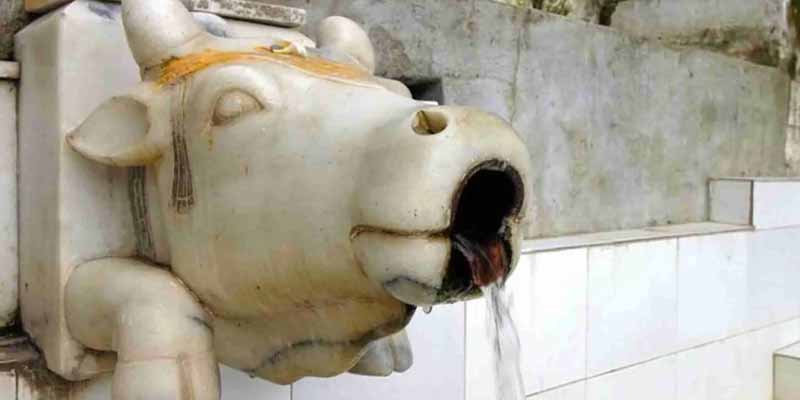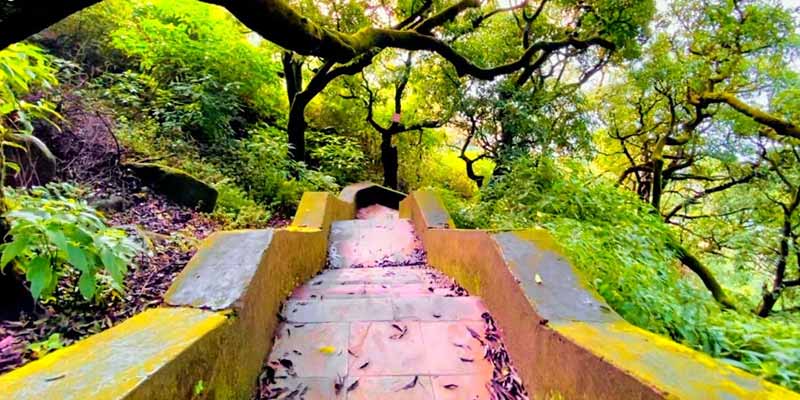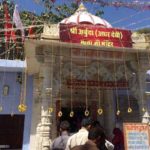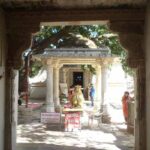Gaumukh Temple Mount Abu is a prominent religious site situated in the charming hill station of Mount Abu in the state of Rajasthan, India. Nestled amidst the lush greenery of the Aravalli Range, this temple holds deep spiritual significance and attracts a steady stream of devotees and tourists throughout the year.
The name “Gaumukh” literally translates to “cow’s mouth” in Hindi. The temple derives its name from a natural spring that resembles a cow’s mouth, which is considered sacred. According to legends, it is believed that this spring is the origin of the holy Saraswati River. The water flowing from the spring is considered pure and is used for various religious ceremonies and rituals.
Dedicated to Lord Rama, the temple serves as a place of worship for devotees seeking blessings, solace, and spiritual enlightenment. The main idol of Lord Rama, accompanied by his consort Sita and his ardent devotee Hanuman, is enshrined within the temple. The serene ambiance and the divine presence within the temple create an atmosphere of tranquility and devotion.
The architecture of Gaumukh Temple is a fusion of Hindu and Jain styles. Intricate carvings, ornate pillars, and vibrant murals embellish the temple walls, reflecting the artistic brilliance of the craftsmen of yesteryears. The unique feature of the temple is the cow’s mouth-shaped structure from which the spring emerges, adding to the temple’s visual allure Mount Abu Monuments.
Apart from its religious significance, the Gaumukh Temple offers breathtaking panoramic views of the surrounding natural beauty. The temple is located atop a hill, providing visitors with a commanding view of the Aravalli Range and the picturesque valleys below. The cool breeze and serene atmosphere make it an ideal spot for meditation, introspection, and rejuvenation of the mind and soul.
Visitors to Gaumukh Temple often engage in ritualistic activities such as offering prayers, performing aarti (a devotional ceremony involving the waving of lamps), and taking a dip in the holy spring. Pilgrims also carry the sacred water back home, believing it to possess auspicious and purifying qualities.
In conclusion, Gaumukh Temple Mount Abu is a sacred destination that blends spirituality, natural beauty, and architectural grandeur. It provides a serene sanctuary where devotees can connect with the divine and seekers of peace can find solace in the lap of nature. A visit to this temple offers a unique opportunity to experience the rich cultural heritage and serene beauty that define Mount Abu.

History of Gaumukh Temple
The history of Gaumukh Temple in Mount Abu is deeply rooted in Hindu mythology and the religious traditions of the region. While the exact origin of the temple is not documented, it is believed to date back several centuries Mount Abu Tour Packages.
According to popular beliefs, Gaumukh Temple holds a connection with the epic Ramayana, an ancient Hindu scripture. It is said that Lord Rama, his wife Sita, and his devotee Hanuman visited Mount Abu during their exile. The temple is believed to have been established at the spot where Lord Rama and his companions halted and drank water from the natural spring that resembles a cow’s mouth.
Over time, the temple gained significance as a revered place of worship. It became a sacred site for devotees who sought blessings and spiritual enlightenment. The local community, as well as rulers and patrons of the region, contributed to the maintenance and expansion of the temple complex.
The architectural style of Gaumukh Temple showcases a blend of Hindu and Jain influences, reflecting the cultural and historical heritage of Mount Abu Tourism. The intricate carvings, beautiful sculptures, and vibrant paintings adorning the temple walls are a testament to the artistic skills of craftsmen from bygone eras.
The temple’s history is intertwined with the cultural fabric of Mount Abu and has witnessed various phases of development and restoration. Over the centuries, the temple complex has been renovated and expanded to accommodate the growing number of devotees. The local community continues to actively participate in the preservation and upkeep of the temple, ensuring its legacy endures.
Today, Gaumukh Temple stands as a symbol of faith and spirituality in Mount Abu. It attracts devotees from far and wide who come to seek blessings and immerse themselves in the serene ambiance of the temple. The historical and mythological significance of the temple, coupled with its natural surroundings, make it a cherished destination for religious and cultural enthusiasts.
In conclusion, the history of Gaumukh Temple in Mount Abu is deeply rooted in mythology and has evolved over time as a place of worship and spiritual significance. Its rich architectural heritage and cultural importance continue to make it an integral part of the religious landscape of Mount Abu.

Best Time to Visit Gaumukh Temple
The best time to visit Gaumukh Temple in Mount Abu is during the months of October to March, which is the winter season in the region. During this time, the weather is pleasant and mild, making it ideal for exploring the temple and enjoying the surrounding natural beauty.
The winter season in Mount Abu is characterized by cool temperatures, with daytime temperatures ranging from 20 to 25 degrees Celsius (68 to 77 degrees Fahrenheit). The evenings can get chilly, so it is advisable to carry some warm clothing. The clear skies and comfortable weather during this season create a favorable environment for sightseeing and outdoor activities.
Another reason why winter is the preferred time to visit Gaumukh Temple is the festive atmosphere that prevails during this period. The region celebrates various festivals like Diwali, Navratri, and Christmas, adding a vibrant and joyful ambiance to the temple and the surrounding areas. Devotees can participate in special prayers and witness the temple adorned with festive decorations.
It’s worth noting that Mount Abu experiences a significant influx of tourists during the winter months, especially during the peak tourist season in December and January. Therefore, it is advisable to plan your visit accordingly and book accommodation in advance to avoid any inconvenience.
While winter is the recommended time, Gaumukh Temple can be visited throughout the year. However, it’s important to consider the weather conditions during other seasons. Summers (April to June) can be hot, with temperatures exceeding 40 degrees Celsius (104 degrees Fahrenheit), making it uncomfortable for outdoor activities. The monsoon season (July to September) brings rainfall, which can hamper travel plans and make the terrain slippery.
In summary, the best time to visit Gaumukh Temple Mount Abu is during the winter season (October to March), when the weather is pleasant, the skies are clear, and festive celebrations add to the spiritual and cultural experience.

How to Reach Gaumukh Temple
To reach Gaumukh Temple in Mount Abu, you can follow these transportation options:
- By Air: The nearest airport to Mount Abu is Maharana Pratap Airport in Udaipur, which is approximately 176 kilometers away. From the airport, you can hire a taxi or take a bus to reach Mount Abu. The journey from Udaipur to Mount Abu takes around 3 to 4 hours.
- By Train: The nearest railway station to Mount Abu is Abu Road Railway Station, which is well-connected to major cities in India. Several trains operate to and from Abu Road. From the railway station, you can hire a taxi or take a local bus to reach Mount Abu, which is about 28 kilometers away. The journey takes around 1 hour.
- By Road: Mount Abu is well-connected to various cities in Rajasthan and neighboring states by a network of roads. You can choose to drive to Mount Abu or take a bus from nearby cities. Regular bus services are available from major cities like Udaipur, Ahmedabad, and Jaipur to Mount Abu. Private taxis and shared cabs are also available for hire.
Once you reach Mount Abu, Gaumukh Temple is located near Nakki Lake and is easily accessible. You can hire a local taxi or take a short walk to reach the temple. The temple is situated on top of a hill, so there might be a flight of stairs to climb to reach the entrance.
It is advisable to check the weather conditions, road conditions, and transportation availability before planning your visit to Gaumukh Temple Mount Abu.








